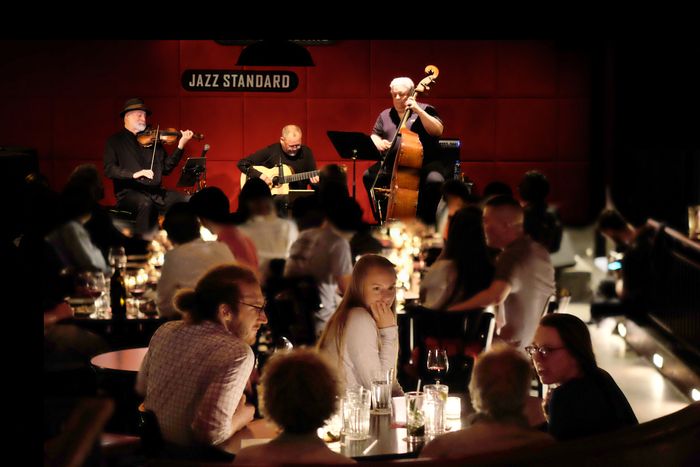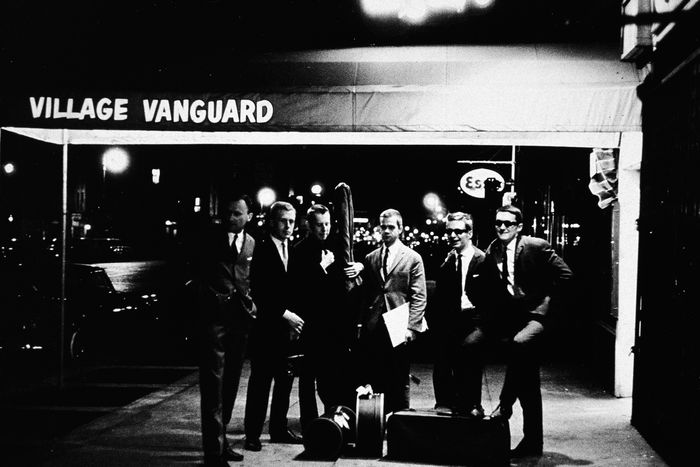
It’s been a lifetime since places like the Three Deuces, Club Carousel, and the Downbeat draped West 52nd Street in neon, and in the time since, the number of clubs maintaining New York’s status as the gigging, beating heart of the jazz world had dwindled to a resilient core — even before the pandemic put the city’s most prominent live art on pause. With the closure of the Jazz Standard announced this week, the community has lost another gem: a large but charismatic venue considered a prestige destination for artists and audiences alike, one with top-dollar pay drawing top-tier talent like the Maria Schneider Orchestra and the weekly Mingus Big Band.
“To be clear, the Jazz Standard was successful,” says Seth Abramson, the artistic director of the club, which first opened in 1997. “It wasn’t in any way a venue that was in trouble pre-pandemic.” But with no revenue coming in, that obviously changed, and the Standard and the restaurant that sits above it, Blue Smoke — both part of Danny Meyer’s Union Square Hospitality Group —could not reach an agreement with a landlord who was “just unwilling to bend in any way to make it feasible.”
The loss goes beyond just one less place for musicians to play in the city that’s been their creative capital for a century now. “It’s this ecosystem where everything relies on the other,” says Abramson, noting how the Standard’s co-sign on up-and-coming players has been able to “reverberate” out among the city’s clubs and eventually lead to bookings in Europe and Japan, the two touring markets where jazz musicians can make real touring money. Depending on how you define “jazz club,” there are barely a dozen in New York. None of them is making anyone rich.
“Every jazz club that presents music is part of a chain, like a food chain, supplying life force to this community,” says Spike Wilner, the owner of Mezzrow and Smalls, two more spots essential to the idea of live jazz in New York, seven days a week until four in the morning. “When the environment dries up, less and less animals are allowed to live.” When we spoke earlier in the pandemic, Wilner had sounded doubtful that the old model of musicians’ subsisting mostly on show money could survive if the clubs go dark. “The gigging lifestyle—where musicians are freelancing from one independent job to another—I don’t know if that’s going to be around in New York after this. You’ll probably see some Mad Max scenario where the young guys claw their way to survival.”
With PPP loans long since spent and de facto austerity measures implemented by the city, state, and federal governments, the fact that even the large backing of the Jazz Standard could not keep the lights on is a grave sign. Deborah Gordon, the owner of the Village Vanguard — jazz’s basement equivalent to Madison Square Garden, the place where Miles and Mingus and Monk played, the place everyone dreams of stepping onstage — says the closing of the Standard makes other venues feel “vulnerable.” “I’m just trying to look at my belt and see if there’s another notch I can pull in,” she says.
Some rays of hope are getting through. The owners of the Vanguard’s building have provided some rent relief, as they’ve become aware of their tenants’ international draw and also that there isn’t really a market for a new tenant in a Manhattan basement right now. It also helps that this business has always been unusually focused on the art it supports and the people who flow through the buildings. Non-profit status at some venues, including Smalls and the Jazz Gallery, have been pivotal to staying afloat. “If you have a nine-to-five regular gig and your life has been about accumulating money and this happens, all of a sudden everything you’ve been working for in your life means nothing,” says Rio Sakairi, the artistic director at the Jazz Gallery. “But we are in live music, and it needs a physical space and a community. Yes, we don’t have money and that worries all of us—but the life goals, and why we are here, that fundamental part hasn’t changed.” The longevity of jazz’s place in New York — a city defined in part by its crisis years — also provides some perspective. “The Vanguard has been through hard times, mostly hard times,” says Gordon. (It opened in 1935, well into the Great Depression.) “It’s like the stock market in a way: It’s not about night-to-night, it’s about decade to decade.”
As for the artists themselves, resiliency is a dominant force, despite the wave of deaths of older jazz musicians at the beginning of the pandemic and the effective halving of income, now restricted mostly to teaching. “For me, for a lot of guys, New York is the reason we’re playing,” says trumpeter Duane Eubanks, adding that even a pandemic can’t get in the way of “an individual sharing ancestral information.” Sax legend Gary Bartz, who’s always taken a cosmic sort of perspective, is confident that the live art will endure. “What ever happened to Birdland? Basin Street East? Fillmore West? My dad had a nightclub—what happened to that? Another club comes. I don’t worry about the music: It’s the humans I worry about.”
Late next year, as a vaccine makes its way slowly — chaotically — to the public and indoor events once again populate to the city’s calendar, unexpected artistic challenges will remain. Eubanks described the difficulties of playing to a quarter-capacity crowd last month at Smalls, which has been circumnavigating State Liquor Authority ticketing rules on ticketing by allowing supporting members of the SmallsLive Foundation to sponsor a seat online and then sit in it later that night. (“It’s kind of a sneaky thing,” Wilner says, of his creative solution. “Maybe they’ll bust us, maybe not. But I don’t really give a shit.”) The thrill of watching the pros often lies in seeing them come together to become a moving, breathing thing, and Eubanks felt that his band’s communication wasn’t quite perfect—and not just because the rhythm section’s faces were covered by masks. “I’m sure guys are practicing at home, but not having that interaction on a regular basis is a totally different thing.” Still, he could notice a “hunger” in the crowd. “I think they realized, ‘wow, these guys are artists, their source of income, their source of internal spirituality has been disrupted totally.’ The crowd was small, but the way they listened to the music was much more receptive.”
The Link LonkDecember 05, 2020 at 06:36AM
https://www.curbed.com/2020/12/mostly-hard-times-how-nycs-jazz-clubs-are-hanging-on.html
‘Mostly Hard Times’: How the City’s Few Jazz Clubs Are Hanging On, Barely - Curbed
https://news.google.com/search?q=hard&hl=en-US&gl=US&ceid=US:en

No comments:
Post a Comment